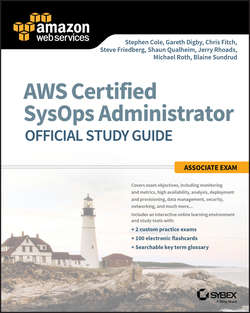Читать книгу AWS Certified SysOps Administrator Official Study Guide - Cole Stephen - Страница 11
На сайте Литреса книга снята с продажи.
Chapter 1
Introduction to Systems Operations on AWS
Systems Operators
ОглавлениеYou are a systems operator, and it is your job to keep your application environments running at maximum performance at all times. Just as a pit crew enables the racecar driver to win a race, systems operators are the pit crew – they help end users function successfully in their day-to-day jobs. You are an AWS systems operator, and this book will help you obtain the AWS Certified SysOps Administrator – Associate certification.
Deploying Systems
You might find yourself manually installing common, off-the-shelf packages on standalone instances. You might be coordinating an enterprise-wide effort to embrace fully-automated continuous deployment/continuous integration. Wherever you are on that spectrum, the responsibility to get it running in the first place falls on your shoulders.
However, deployment comprises much more than initializing systems. As enterprises evolve from monolithic application servers to container services, micro services, and serverless architectures, keeping up with the continuous stream of service updates requires attention and automation that you must manage.
Monitoring Systems
You might have a wall of monitors, all rendering real-time data on the environments in your care. You might have fully-automated alert functions that respond to changes in behavior, repairing or replacing failing parts and keeping you informed of these adjustments.
Nonetheless, you are monitoring much more than just network latency or CPU consumption. You have analytic engines that trace patterns in user behaviors – both consumers and employees. Your bots constantly review log files, looking for unusual activity and notifying you of anomalies.
Optimizing Systems
As a systems operator, you are your company’s best agent for maximizing performance because your analytics help you choose the correct infrastructure configuration, the optimal storage methods, and the best possible customer outcome.
By 123net – Own work, CC BY-SA 3.0, https://commons.wikimedia.org/w/index.php? curid=17384917
However, you do more than optimize for speed; you optimize for cost. By using elastic environments, your environment not only automatically scales out during peak demand to minimize latency, but it also automatically scales in later to minimize spend. You manage an environment that is highly utilized every hour of every day.
Fortifying Systems
Things break and systems go offline, but you don’t let that keep you up at night. You maintain highly available architectures: systems that detect failed components and automatically switch over, replacing and restoring as needed without interruption of service to your consumers.
But your availability methods cover more than single regions and multiple Availability Zones. Systems operations on AWS involves using multi-region and hybrid methods when needed to ensure continuity of operations no matter what Mother Nature throws at you.
Securing Systems
The combination of security groups, access control lists, and private networks in concert with native tools such as Amazon CloudFront and AWS Shield, help your environment stand up to the most sinister of attacks.
Threats don’t always come from the outside, however. You know that the most dangerous vector is the internal attack. That’s why you have meticulously employed a policy of compartmentalized, restricted privilege sets so that no one can step into unauthorized territory, along with detailed Application Programming Interface (API) logging that reports on all actions to provide comprehensive control over your assets.
